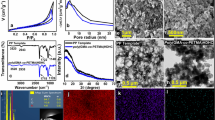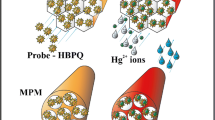Abstract
In this article, we demonstrate the fabrication and application of a naked eye–responsive solid-state Cu2+ opto-chemosensor for the detection and recovery of Cu2+ from various environmental water samples. The colorimetric ion sensor is fabricated by physically anchoring a 4-hexyl-6-(quinolin-8-yldiazenyl) benzene-1,3-diol (HQDB) chelating probe, onto the indigenously designed silica-polymer hybrid monolith host template, and is systematically characterized. The inimitable macroporous backbone with the continuous interconnected mesoporous web structure of the monolith template offers greater immobilization of the ligand molecules onto its surface. The porous hybrid monolithic framework provides better accessibility towards the probe chelating sites for the Cu2+, thereby offering a faster visual response within 2 min of contact time. The sensor enables a unique visible color transition from yellowish orange to dark brown due to the formation of stable 1:1 [Cu2+-HQDB] (λmax 480 nm) charge-transfer complexes. The solid sensor exhibits high efficiency of sensing at pH 8.0, with a limit of detection (LOD) and quantification (LOQ) values of 0.45 and 1.5 ppb, respectively. Moreover, the solid sensor proffers remarkable selectivity towards Cu2+, which makes it more useful for real-time analysis, within a short analysis time. The porous monolithic sensor is reusable for eight cycles of sensing applications with greater data reproducibility when applied to real water samples.
Graphical abstract








Similar content being viewed by others
References
Adhoum N, Monser L, Bellakhal N et al (2004) Treatment of electroplating wastewater containing Cu2+, Zn2+ and Cr6+ by electrocoagulation. J Hazard Mater 112:207–213. https://doi.org/10.1016/j.jhazmat.2004.04.018
Ait Ouaissa YA, Chabani M, Amrane A et al (2013) Removal of Cr (VI) from model solutions by a combined electrocoagulation sorption process. Chem Eng Technol 36:147–155. https://doi.org/10.1002/ceat.201200375
Akbal F, Camci S (2010) Comparison of electrocoagulation and chemical coagulation for heavy metal removal. Chem Eng Technol 33:1655–1664. https://doi.org/10.1002/ceat.201000091
Alyüz B, Veli S (2009) Kinetics and equilibrium studies for the removal of nickel and zinc from aqueous solutions by ion exchange resins. J Hazard Mater 167:482–488. https://doi.org/10.1016/j.jhazmat.2009.01.006
Awual MR (2015) A novel facial composite adsorbent for enhanced copper (II) detection and removal from wastewater. Chem Eng J 266:368–375. https://doi.org/10.1016/j.cej.2014.12.094
Awual MR (2017) New type mesoporous conjugate material for selective optical copper (II) ions monitoring & removal from polluted waters. Chem Eng J 307:85–94. https://doi.org/10.1016/j.cej.2016.07.110
Awual MR (2019) Novel ligand functionalized composite material for efficient copper (II) capturing from wastewater sample. Compos Part B Eng 172:387–396. https://doi.org/10.1016/j.compositesb.2019.05.103
Awual MR, Hasan MM (2015) Colorimetric detection and removal of copper (II) ions from wastewater samples using tailor-made composite adsorbent. Sensors Actuators B Chem 206:692–700. https://doi.org/10.1016/j.snb.2014.09.086
Awual MR, Rahman IMM, Yaita T et al (2014) PH dependent Cu (II) and Pd (II) ions detection and removal from aqueous media by an efficient mesoporous adsorbent. Chem Eng J 236:100–109. https://doi.org/10.1016/j.cej.2013.09.083
Awual MR, Hasan MM, Khaleque MA et al (2016) Treatment of copper (II) containing wastewater by a newly developed ligand based facial conjugate materials. Chem Eng J 288:368–376. https://doi.org/10.1016/j.cej.2015.11.108
Awual MR, Yaita T, Kobayashi T et al (2020a) Improving cesium removal to clean-up the contaminated water using modified conjugate material. J Environ Chem Eng 8:103684. https://doi.org/10.1016/j.jece.2020.103684
Awual MR, Hasan MM, Iqbal J et al (2020b) Naked-eye lead (II) capturing from contaminated water using innovative large-pore facial composite materials. Microchem J 154:104585. https://doi.org/10.1016/j.microc.2019.104585
Bo C, Ping Z (2005) A new determining method of copper (II) ions at ng ml-1 levels based on quenching of the water-soluble nanocrystals fluorescence. Anal Bioanal Chem 381:986–992. https://doi.org/10.1007/S00216-004-2963-9
Campos CH, Urbano BF, Rivas BL (2014) Synthesis and characterization of organic-inorganic hybrid composites from poly (acrylic acid)-[3-(trimethoxysilyl) propyl methacrylate]-Al2O 3. Compos Part B Eng 57:1–7. https://doi.org/10.1016/j.compositesb.2013.09.031
Cao Y, Liu Y, Li F et al (2019) Portable colorimetric detection of copper ion in drinking water via red beet pigment and smartphone. Microchem J 150:104176. https://doi.org/10.1016/j.microc.2019.104176
Chen H, Zhang J, Liu X et al (2014) Colorimetric copper (II) ion sensor based on the conformational change of peptide immobilized onto the surface of gold nanoparticles. Anal Methods 6:2580–2585. https://doi.org/10.1039/c3ay42211a
Cheng Y-m, Fa H-b, Yin W et al (2016) A sensitive electrochemical sensor for lead based on gold nanoparticles/nitrogen-doped graphene composites functionalized with l-cysteine-modified electrode. J Solid State Electrochem 20:327–335. https://doi.org/10.1007/s10008-015-3043-0
Desai V, Kaler SG (2008) Role of copper in human neurological disorders. Am J Clin Nutr 88:855S-858S. https://doi.org/10.1093/ajcn/88.3.855S
Ding B, Si Y, Wang X et al (2011) Label-free ultrasensitive colorimetric detection of copper (II) ions utilizing polyaniline/polyamide-6 nano-fiber/net sensor strips. J Mater Chem 21:13345–13353. https://doi.org/10.1039/c1jm11851
Doula MK, Dimirkou A (2008) Use of an iron-overexchanged clinoptilolite for the removal of Cu2+ ions from heavily contaminated drinking water samples. J Hazard Mater 151:738–745. https://doi.org/10.1016/j.jhazmat.2007.06.047
El-Safty SA (2009) Functionalized hexagonal mesoporous silica monoliths with hydrophobic azo-chromophore for enhanced Co (II) ion monitoring. Adsorption 15:227–239. https://doi.org/10.1007/s10450-009-9171-z
El-Safty SA, Shenashen MA, Ismael M et al (2013) Mesoporous aluminosilica sensors for the visual removal and detection of Pd(II) and Cu(II) ions. Microporous Mesoporous Mater:195–205. https://doi.org/10.1016/j.micromeso.2012.03.021
Gao Q, Ji L, Wang Q et al (2017) Colorimetric sensor for highly sensitive and selective detection of copper ion. Anal Methods 9:5094–5100. https://doi.org/10.1039/c7ay01335c
Ghodake GS, Shinde SK, Saratale RG et al (2018) Colorimetric detection of Cu2+ based on the formation of peptide-copper complexes on silver nanoparticle surfaces. Beilstein J Nanotechnol 9:1414–1422. https://doi.org/10.3762/bjnano.9.134
Grimm J, Bessarabov D, Sanderson R (1998) Review of electro-assisted methods for water purification. Desalination 115:285–294. https://doi.org/10.1016/S0011-916(98)00047-2
Guo Y, Wang Z, Qu W et al (2011) Colorimetric detection of mercury, lead and copper ions simultaneously using protein-functionalized gold nanoparticles. Biosens Bioelectron 26:4064–4069. https://doi.org/10.1016/j.bios.2011.03.033
Gupta VK, Ganjali MR, Norouzi P et al (2011) Electrochemical analysis of some toxic metals by ion-selective electrodes. Crit Rev Anal Chem 41:282–313. https://doi.org/10.1080/10408347.2011.589773
Hu J, Wang L, Zhang X et al (2021) Selective colorimetric detection of copper (II) by a protein-based nanoprobe. Spectrochim Acta A Mol Biomol Spectrosc 252:119462. https://doi.org/10.1016/j.saa.2021.119462
Huo FJ, Su J, Sun YQ et al (2010) A rhodamine-based dual chemosensor for the visual detection of copper and the ratiometric fluorescent detection of vanadium. Dye Pigment 86:50–55. https://doi.org/10.1016/j.dyepig.2009.11.007
Ji C-h, Li J-j, Hou C-j et al (2017) Mesoporous hollow silica shells modified with functional diamine groups show high-performance absorption capacity and selective colorimetric response to copper ions in aqueous solutions. Sensors Actuators B Chem 240:718–725. https://doi.org/10.1016/j.snb.2016.09.017
Jo J, Lee HY, Liu W et al (2012) Reactivity-based detection of copper (II) ion in water: oxidative cyclization of azoaromatics as fluorescence turn-on signaling mechanism. J Am Chem Soc 134:16000–16007. https://doi.org/10.1021/ja307316s
Kim HJ, Lee SJ, Park SY et al (2008) Detection of Cu II by a chemodosimeter-functionalized monolayer on mesoporous silica. Adv Mater 20:3229–3234. https://doi.org/10.1002/adma.200800246
Kirubaharan CJ, Kalpana D, Lee YS et al (2012) Biomediated silver nanoparticles for the highly selective copper (II) ion sensor applications. Ind Eng Chem Res 51:7441–7446. https://doi.org/10.1021/ie3003232
Kubra KT, Salman MS, Hasan MN et al (2021) Utilizing an alternative composite material for effective copper (II) ion capturing from wastewater. J Mol Liq 336:116325. https://doi.org/10.1016/j.molliq.2021.116325
Kumar J, Bhattacharyya PK, Das DK (2015) New dual fluorescent “on-off” and colorimetric sensor for copper (II): copper (II) binds through N coordination and pi cation interaction to sensor. Spectrochim Acta A Mol Biomol Spectrosc 138:99–104. https://doi.org/10.1016/j.saa.2014.11.030
Liu R, Chen Z, Wang S et al (2013) Colorimetric sensing of copper (II) based on catalytic etching of gold nanoparticles. Talanta 112:37–42. https://doi.org/10.1016/j.talanta.2013.01.065
Lv SW, Liu JM, Li CY et al (2019) A novel and universal metal-organic frameworks sensing platform for selective detection and efficient removal of heavy metal ions. Chem Eng J 375:112111. https://doi.org/10.1016/j.cej.2019.122111
Ma YR, Niu HY, Le ZX et al (2011) Colorimetric detection of copper ions in tap water during the synthesis of silver/dopamine nanoparticles. Chem Commun 47:12643–12645. https://doi.org/10.1039/c1cc15048k
Maçon ALB, Page SJ, Chung JJ et al (2015) A structural and physical study of sol-gel methacrylate-silica hybrids: intermolecular spacing dictates the mechanical properties. Phys Chem Phys 17:29124–29133. https://doi.org/10.1039/c5cp04656d
Mohammadi A, Khalili B, Haghayegh AS (2019) A novel chromone based colorimetric sensor for highly selective detection of copper ions: synthesis, optical properties and DFT calculations. Spectrochim Acta A Mol Biomol Spectrosc 222:117–193. https://doi.org/10.1016/j.saa.2019.117193
Park GJ, Hwang IH, Song EJ et al (2014) A colorimetric and fluorescent sensor for sequential detection of copper ion and cyanide. Tetrahedron 70:2822–2828. https://doi.org/10.1016/j.tet.2014.02.055
Ratnarathorn N, Chailapakul O, Henry CS et al (2012) Simple silver nanoparticle colorimetric sensing for copper by paper-based devices. Talanta 99:552–557. https://doi.org/10.1016/j.talanta.2012.06.033
Shahat A, Hassan HMA, El-Shahat MF et al (2018) Visual nickel (II) ions treatment in petroleum samples using a mesoporous composite adsorbent. Chem Eng J 334:957–967. https://doi.org/10.1016/j.cej.2017.10.105
Shen Q, Li W, Tang S et al (2013) A simple “clickable” biosensor for colorimetric detection of copper (II) ions based on unmodified gold nanoparticles. Biosens Bioelectron 41:663–668. https://doi.org/10.1016/j.bios.2012.09.032
Smit E, Leeflang P, Wernars K (1997) Change in microbial community due to copper pollution - Smit et al. 1997.pdf. FEMS Microbiol Ecol 23:249–261. https://doi.org/10.1111/j.1574-6941.1997.tb00407.x
Song Y, Qu K, Xu C et al (2010) Visual and quantitative detection of copper ions using magnetic silica nanoparticles clicked on multiwalled carbon nanotubes. Chem Commun 46:6572–6574. https://doi.org/10.1039/c0cc01593
Su YT, Lan GY, Chen WY et al (2010) Detection of copper ions through recovery of the fluorescence of DNA-templated copper/silver nanoclusters in the presence of mercaptopropionic acid. Anal Chem 82:8566–8572. https://doi.org/10.1021/ac101659d
Tabrizi AB (2007) Development of a cloud point extraction-spectrofluorimetric method for trace copper (II) determination in water samples and parenteral solutions. J Hazard Mater 139:260–264. https://doi.org/10.1016/j.jhazmat.2006.06.024
Valls M, De Lorenzo V (2002) Exploiting the genetic and biochemical capacities of bacteria for the remediation of heavy metal pollution. FEMS Microbiol Rev 26:327–338. https://doi.org/10.1016/S0168-6445(02)00114-6
Wang Z, Wang M, Wu G et al (2014) Colorimetric detection of copper and efficient removal of heavy metal ions from water by diamine-functionalized SBA-15. Dalt Trans 43:8461–8468. https://doi.org/10.1039/c3dt53641f
Wang N, Liu Y, Li Y et al (2018) Fluorescent and colorimetric sensor for Cu2+ ion based on formaldehyde modified hyperbranched polyethylenimine capped gold nanoparticles. Sensors Actuators B Chem 255:78–86. https://doi.org/10.1016/j.snb.2017.08.035
Weng Z, Wang H, Vongsvivut J et al (2013) Self-assembly of core-satellite gold nanoparticles for colorimetric detection of copper ions. Anal Chim Acta 803:128–134. https://doi.org/10.1016/j.aca.2013.09.036
Wong CSC, Li X, Thornton I (2006) Urban environmental geochemistry of trace metals. Environ Pollut 142:1–16. https://doi.org/10.1016/j.envpol.2005.09.004
Xiao F, Howard Huang JC (2009) Comparison of biosorbents with inorganic sorbents for removing copper (II) from aqueous solutions. J Environ Manage 90:3105–3109. https://doi.org/10.1016/j.jenvman.2009.05.018
Xu LQ, Neoh KG, Kang ET et al (2013) Rhodamine derivative-modified filter papers for colorimetric and fluorescent detection of Hg2+ in aqueous media. J Mater Chem A 1:2526–2532. https://doi.org/10.1039/c2ta01072k
Yin BC, Ye BC, Tan W et al (2009) An allosteric dual-DNAzyme unimolecular probe for colorimetric detection of copper (II). J Am Chem Soc 131:14624–14625. https://doi.org/10.1021/ja9062426
Zeng L, Miller EW, Pralle A et al (2006) A selective turn-on fluorescent sensor for imaging copper in living cells. J Am Chem Soc 128:10–11. https://doi.org/10.1021/ja055064u
Zhou S, He H, Guo W et al (2019) Structural design of a high sensitivity biomass cellulose-based colorimetric sensor and its in situ visual recognition mechanism for Cu2+. Carbohydr Polym 219:95–104. https://doi.org/10.1016/j.carbpol.2019.04.094
Acknowledgements
The authors thank VIT, IIT-Madras, IISc, and BIT-Bengaluru for the instrumentation facilities.
Funding
The authors thank the financial support provided by VIT Vellore (Institute Seed Grant, 2020–2021).
Author information
Authors and Affiliations
Corresponding author
Ethics declarations
Ethics approval
The authors also state that the current research does not involve any human or animal participation.
Conflict of interest
The authors declare no competing interests.
Additional information
Publisher’s note
Springer Nature remains neutral with regard to jurisdictional claims in published maps and institutional affiliations.
Highlights
• Solid-state sensor using porous silica/polymer hybrid monolith immobilized with HQDB probe.
• The sensor offers excellent selectivity and sensitivity for the optical sensing of Cu2+ ions.
• The sensor exhibits the real-time sensing ability of ultra-trace Cu2+ in real water samples.
• The developed Cu2+ hybrid sensor is benign, reusable, durable, fast-responsive, and cost-effective.
Supplementary Information
Below is the link to the electronic supplementary material.
Rights and permissions
About this article
Cite this article
Krishna Kumar, S., Mohan, A.M. Porous inorganic/organic hybrid monolith-based solid sensor for the colorimetric analysis of Cu2+ ions. J Nanopart Res 23, 194 (2021). https://doi.org/10.1007/s11051-021-05316-z
Received:
Accepted:
Published:
DOI: https://doi.org/10.1007/s11051-021-05316-z




